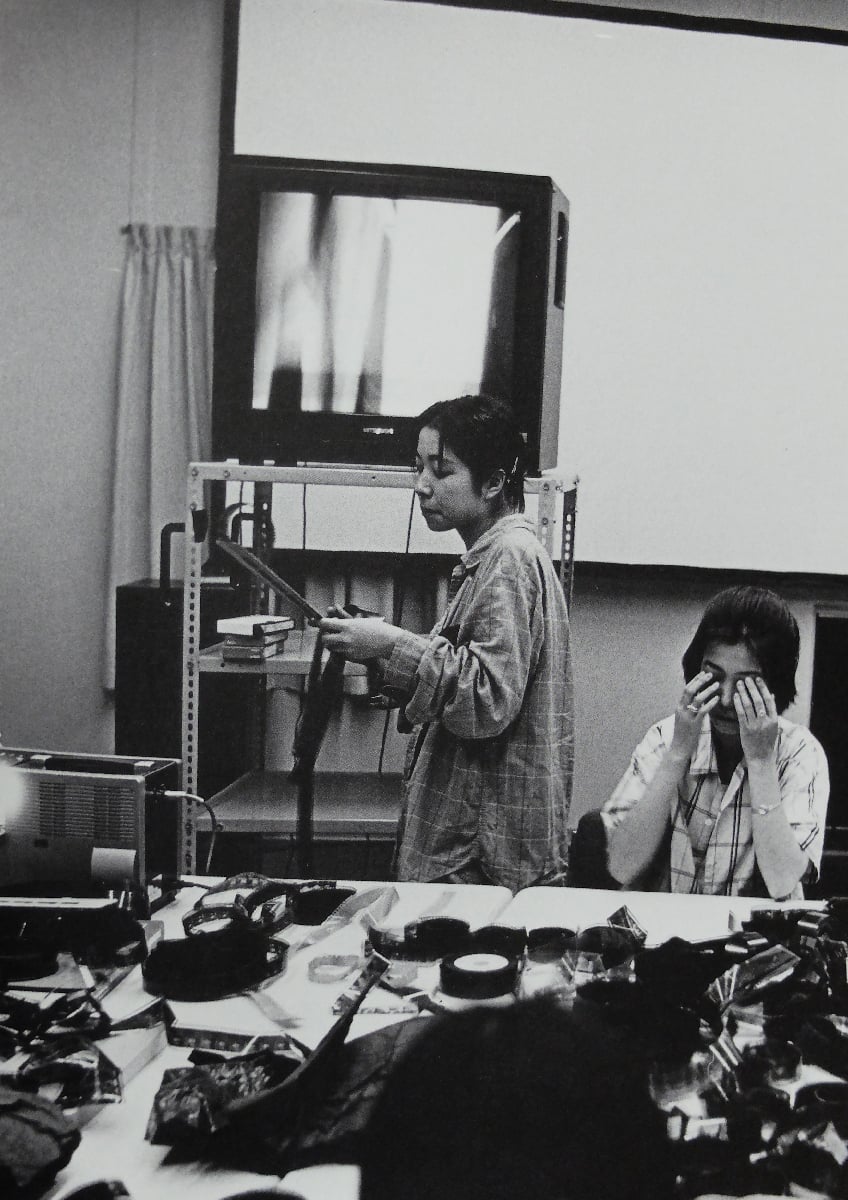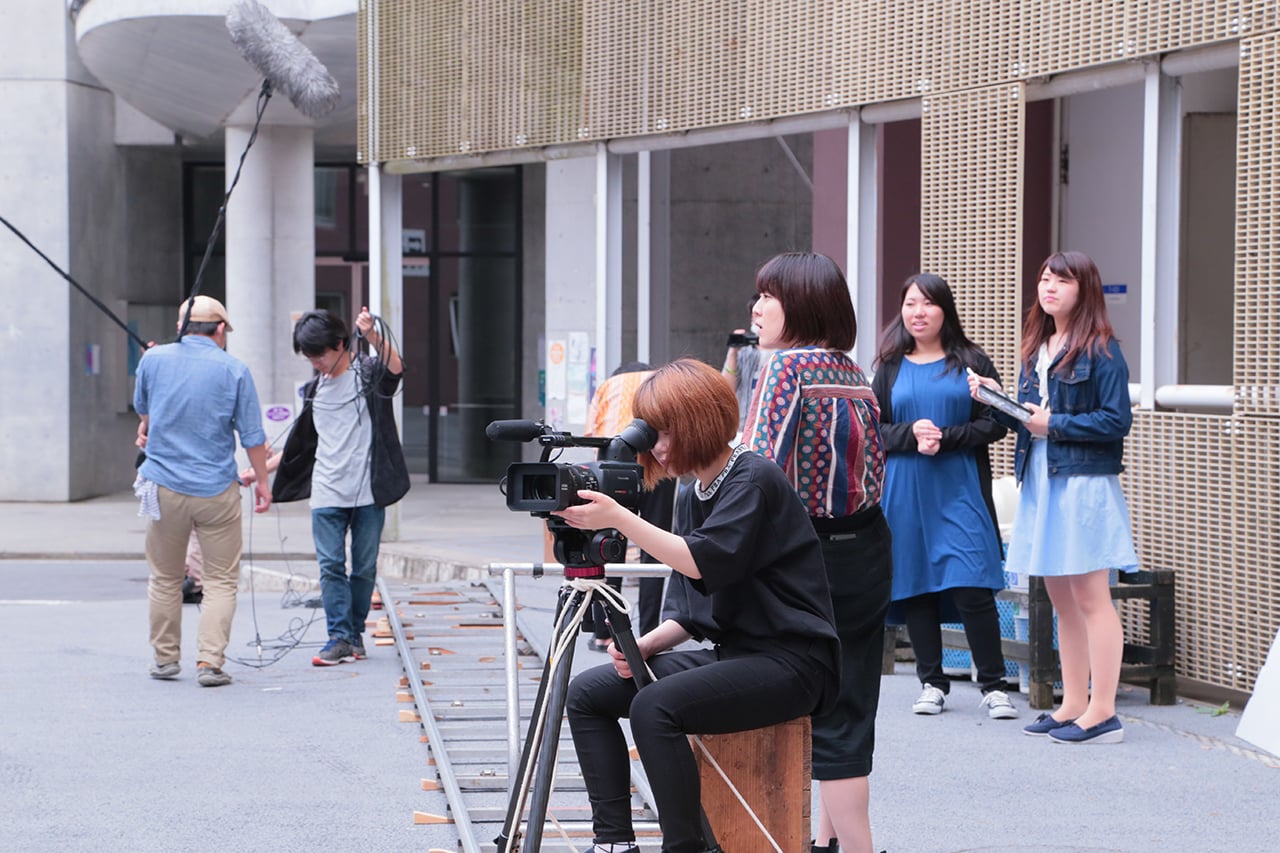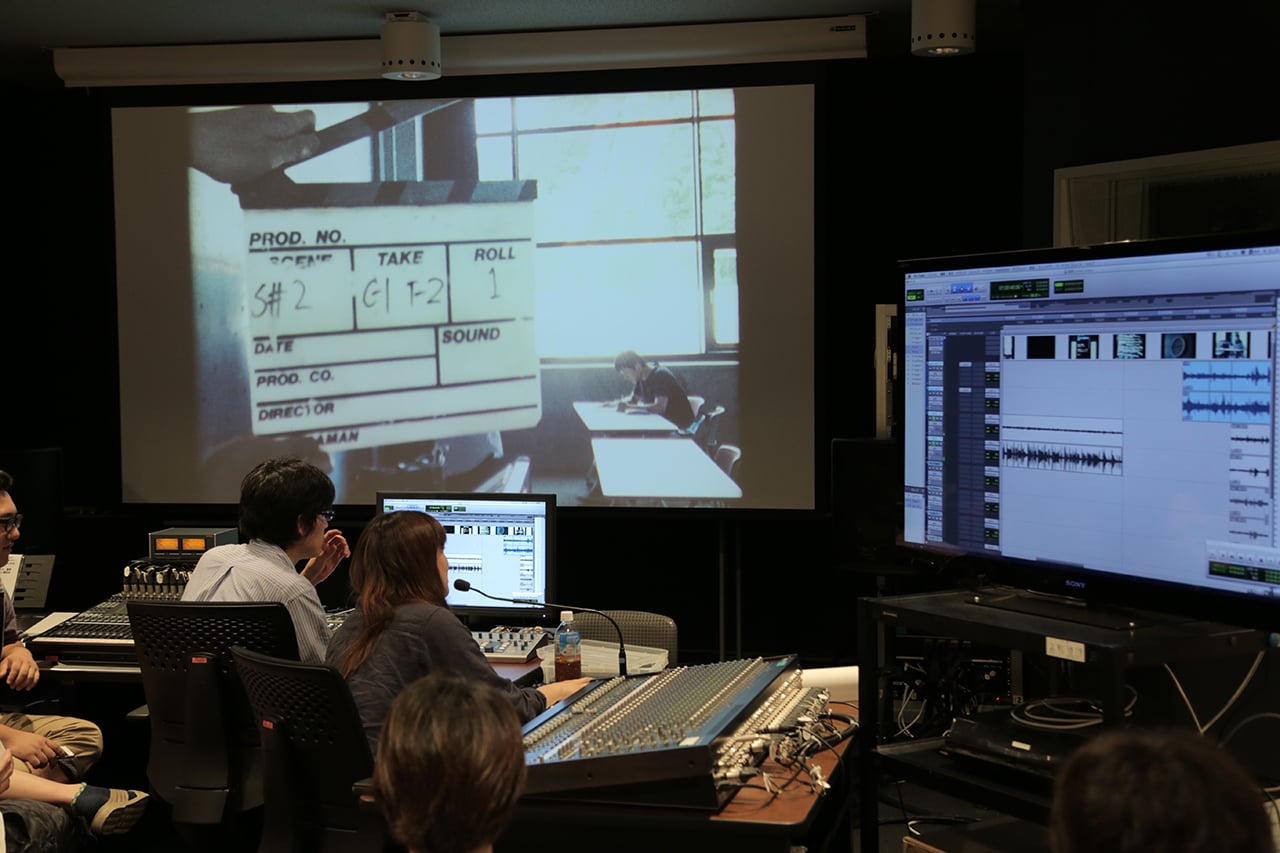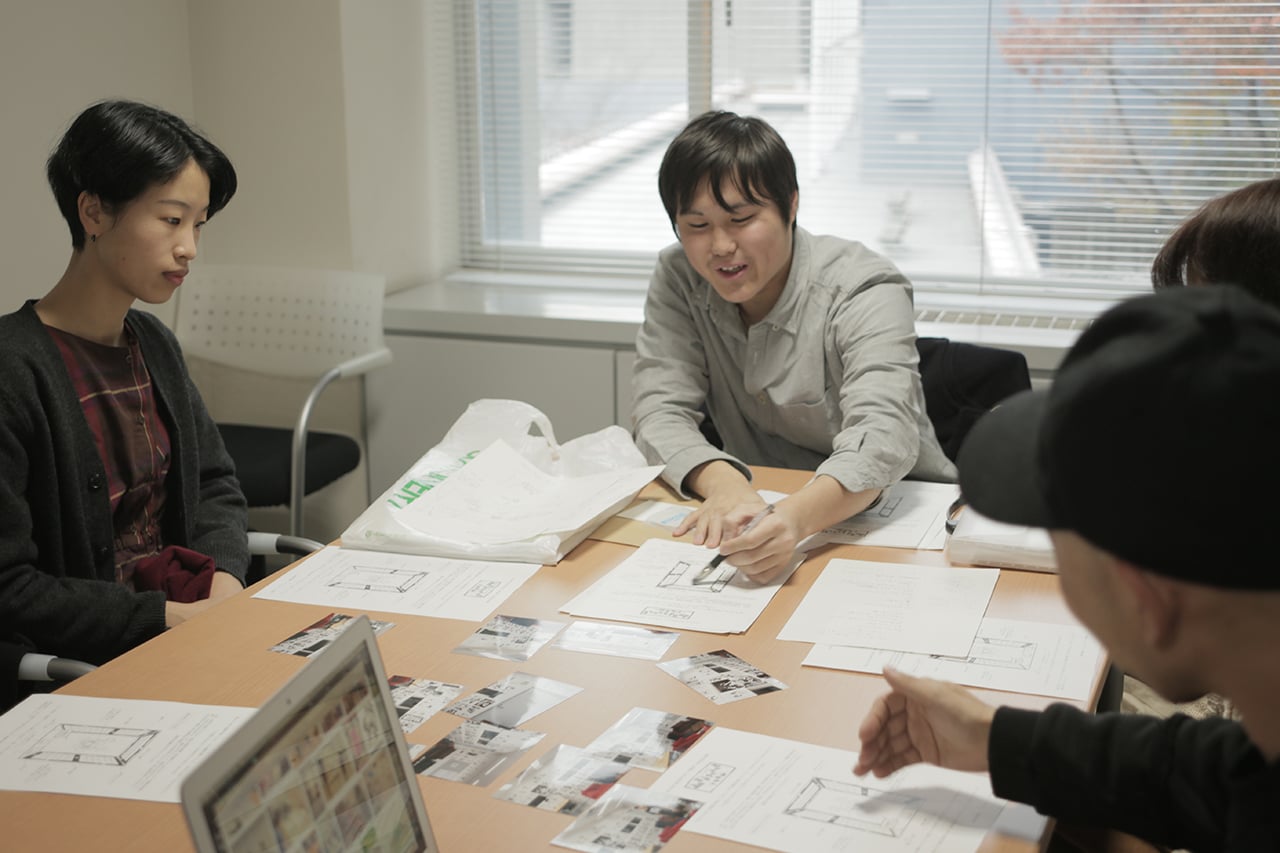私たちについて
われわれは、ジャンルで表現を区別しない。既存を疑う。
ここは、映画の父リュミエール以来の「映像のドキュメンタリー性」を全ての映画映像表現の可能性の核に据え、足元のリアルと、フィクショナルな想像の彼方を、アクロバティックに架橋する自分なりの方法を実験・開発するファクトリー。
ここでは日々、〈わたし〉の孤独や不安を手放すことなく、〈あなた〉との未知なる出遭いに賭ける。
Here 〈此処〉 と There〈他処〉 を、過去と未来を、自分と他者を、あらゆる二元論を超えて媒介させる「映画映像表現」を探求しています。
「生きること=表現すること」の絶えざる実践として、この世界を「見ること」と「聴くこと」のプロフェッショナルになるために。

沿革「アンチ!(反対!)既存の映画」
東京造形大学が出来たのは1966年。
それまで日本の大学で映画制作を学べる場は、日本大学芸術学部映画学科だけでした。しかし、1966年、前衛映画作家・実験映画作家であり優れた理論家でもあった松本俊夫らの協力を得て、日本の大学で初めて「映像」という言葉を冠した授業が行われました。そして、1971年、当時気鋭の映画批評家で映像研究者の波多野哲朗を中心に、大学として日本で2番目に映画を学べる専攻が創設されました。その時の彼らの旗印は 「アンチ ! (反対 ! ) 既存の映画」でした。それまでの既存の映画や映画制作に対しての、クールで大胆な批判を武器にして、新しい映画映像表現の可能性を模索するための狼煙を上げたのです。やがて、この動きは1972年の日本映像学会の発足にも繋がっていきました。
現在は、映像テクノロジーの発展によって、多種多様な大学で様々に映画映像制作が教えられていますが、東京造形大学の映画・映像専攻は、一貫して、変容を続ける映像メディアと社会の在り様への絶えざる批評眼と、その中で人間の生の実践としての表現力を、共に養っていける共同体を目指してきました。
大学で生まれた「映画の学びの繁栄と衰退」
映画は、19世紀に写真とアニメーションの原理を応用し、わずか数分の白黒のフィルムによる動画像=見世物として生み出されました。20世紀にはその産業のあり方の追求、芸術的価値の探究も行われることで、理論、技術が共に発達し現在に至るような、巨大な産業かつ身近な芸術表現として確立します。一方、欧州や北米の大学では、こうしたあり方を捉えるべく、「映画学」の領域が生まれ、国際的に経験と知の保存、さらに論理的な飛躍が目指されました。
しかし、 映画は現在までに素晴らしい体験を生み出した一方で、かつて持っていた進取の気性は他のメディアの到来によって、その意味が固定化されてきたのもまた事実です。例えばビデオ、パブリックビューイング、DVD、ネットによる配信などの他の映像メディアに比べると技術や理論ともに制限が多く、映画がもっていた自由さは失われつつあります。一方で、映像も、すでにある興行的な利害に準じたジャンルというアプローチに依存しつつあります。そしてこうした現状に対し多くの教育研究機関がそれぞれの方法で実践、考察を行ってきました。

東京造形大学の映画・映像専攻
「映画/映像というメディアの可能性」
同様に東京造形大学でも映像前史といえる拡張映画から旧来の産業の映画、インスタレーション等の造形芸術表現を実践、理論の構築が行われてきました。こうした中で、映画を構成する一つの素材である「映像」、また映像のジャンルの1つである「映画」という従来的な枠組みを再考するため、カリキュラムに映画と映像という二つの領域を切り分けることなく、その両義的な性質を常に内包させたカリキュラムを構築してきました。
それは映画/映像を、ジャンルの問題ではなく、身体、空間、時間というイメージを超え、再び世界へ映し出す、驚きをもって迎えられた可能性のメディアとして捉えるということ。ここは、次世代の映画/映像を創造する教育研究機関です。
そのため映画・映像専攻では、映画の役割(監督、脚本、俳優、音声、カメラ、アシスタントなど)。過程(企画、撮影、編集、配給、上映、批評)。映像のジャンル分け(ホームフィルム、CM、ドラマ、映画作品など)と、再生媒体の違い(インターネット、ヴィデオ、放送、映画館など)に代表される現代的な線引きを、総合的に捉えることで、未知の可能性を、共に造形しています。

専攻の授業
「プロジェクトから多角的に映画を探究する」
具体的な教育には、プレゼンテーション、グループワークなどの一つ一つの過程を必然的に行うようになっています。
それらは、ドキュメンタリー、フィクションに限らず企画、脚本、監督、音声、カメラ、編集の役割を固定しないロールプレイングな方法が基盤となっています。
授業で紹介されるものは、映画作品だけでなく、MV、ドラマ、ニュース映像、ホームビデオ、音楽作品、インスタレーション、舞台、論文、エッセイ、など多彩です。また、配給、上映方法の探究の支援、映画や身体のワークショップ、現代芸術としての映画の作品、インスタレーションの批評が、授業に組み込まれ、学生の卒業研究としても指導されています。
機材はフィルムや初期のビデオ、その周辺機器を保管しており、また、デジタルの高スペックな機器から、ハンディーカム、モニターやプロジェクターなども貸し出すことで個々の探究を支援します。

指標「人類の造形知に付与する」
こうした対象を扱う教育研究は専門に閉じたプロフェッショナルのためだけに向けられた授業ではありません。もっと言えば、映画、映像のみが研究の絶対的な対象というわけでもありません。ここ映画・映像専攻では、映画・映像というものにより、いかに人類の造形知を育み、社会に附与するか、ということが教育上、研究上の大きなミッションです。そして、そのための探究が日々行われています。
English
TOKYO ZOKEI UNIVERSITY Film & Moving image Major - Department of design
The spirit of the founding of Tokyo Zokei University
Tokyo Zokei University (TZU) was founded in 1966 by Yoko Kuwasawa and her supporters.
In her book published for the tenth anniversary of the university, she wrote as follows: “The idea of establishing the university occurred to me on the tenth anniversary of Kuwasawa Design School.
The progress of Kuwasawa Design Research Institute inspired me to create a university where various problems concerning design directly connected to human life can be investigated. It was also my hope that the new institution would involve general education including basic cultural, social and natural sciences, and that a kind of applied science, i.e., the theory of Zokei, a broader concept of design and fine arts, would be researched and be established.”
“The idea was interdisciplinary. At the same time, I had a strong desire to elucidate the essence of modern Zokei by pursing the connection between Zokei and pure art.” The spirit of the founding of TZU is based on Yoko Kuwasawa’s educational ideas, i.e., clarification of the meaning of modern Zokei and establishment of the theory of Zokei based on a synthetic viewpoint, which can be recognized in her activities as a designer. In other words, Yoko Kuwasawa herself is the symbol of the spirit of the university and the basis of its educational ideas.
The philosophy implied in the word “ZOKEI”
Tokyo Zokei University is the first university ever in Japan that has the word “Zokei” in its name. By using the word “Zokei”, we express our thought and strong will toward education and research, which is focused on positively accepting the new consciousness of the society which is heading toward the historical changes of art-style in the act of expression and broadening the boundary of expression. The word “Zokei” does not only refer to the visual form or an expression, as is generally understood, but it also indicates the standpoint to acknowledge “art” and “design” as a whole: Going beyond the boundary of synthesizing “art” and “design”, “Zokei” is based on the viewpoint that we acknowledge all kinds of executions and expressions as a part of social performance.
About Film & Moving image Major
Film was born at the end of 19th century, and it gained public recognition in no time. And it rushed all down the path to become the gigantic industry of today. At the same time, there arose a movement to see film as a new art. Both overlapping with each other, formed the system of film.
By the coming in of TV and video technology, the concept of “film” so far had to be widely broadened into a new concept so called “Audio-Visual Contents”. One of these trends appeared through a medium created by quite a personal sensitivity. For example, what came to be called the “new cinema”, which is quite a personal way of expression, is one of the new trends and it came to be recognized by the society.
In the Film Major, we grasp this broadened concept of Audio-Visual Contents as a trend of cultural and artistic expression. Understanding the history, we seek for a new possibility of personal expression in two fields: Film expression and Audio-Visual Expression.
What is conspicuous about Zokei’s film making is that every student takes part in the whole making of the film from the beginning to the end, instead of having partial responsibilities. In other words we do not divide them in parts, such as: Producer, Scenario Writer, Director, Camera Operator, Mixer, etc. Another merit of learning at Zokei is that you can study not only Film but also Graphic Design, Animation, Interior Architecture, and Textile, through Common Subjects provided in the Department of Design. By becoming friends with students of other major, you can get help from them in making of film. This is a good environment for film-making.